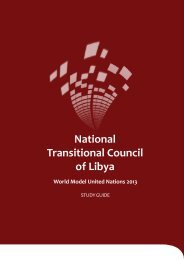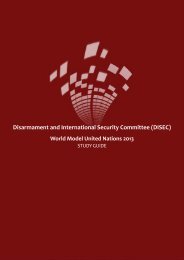Social, Humanitarian and Cultural Committee (SOCHUM)
Social, Humanitarian and Cultural Committee (SOCHUM)
Social, Humanitarian and Cultural Committee (SOCHUM)
Create successful ePaper yourself
Turn your PDF publications into a flip-book with our unique Google optimized e-Paper software.
most widely spoken languages were Nahuatl of the<br />
Aztec Empire <strong>and</strong> Quechua of the Inca Empire, <strong>and</strong><br />
small communities employed thous<strong>and</strong>s of other<br />
unique languages; over the course of two centuries<br />
following the Spanish colonization, many of these<br />
smaller languages became extinct, <strong>and</strong> the number<br />
<strong>and</strong> prestige of Nahuatl <strong>and</strong> Quechua speakers<br />
dropped significantly. 15 Originally, the Spanish<br />
conquerors used Nahuatl or Quechua as a lingua<br />
franca only for their colonial administration <strong>and</strong><br />
missionary work, but as more Spanish settlers came<br />
to Latin America, Spanish gradually replaced these<br />
indigenous languages in most public domains. 16<br />
Invasion <strong>and</strong> colonization are often quickly<br />
followed by the spread of disease, which can have<br />
a deadly effect on a population <strong>and</strong> its languages.<br />
Approximately 90% of the indigenous population<br />
of the Americas died because of diseases that the<br />
Europeans brought with them, most significantly<br />
smallpox; the death of the vast majority of the<br />
indigenous population was accompanied by a<br />
drastic drop in the speakers of all of the native<br />
languages <strong>and</strong> the disappearance of many language<br />
communities. 17 While no longer accompanied by<br />
colonization, the spread of disease remains a major<br />
threat to the existence of many minority languages<br />
today. The HIV/AIDS epidemic in Africa, for example,<br />
disproportionately affects minority populations,<br />
many of whom have their own languages. In Nigeria,<br />
many of the smallest of the 470 languages have seen<br />
a drop in the number of speakers in the past thirty<br />
years because of deaths related to the HIV virus. 18<br />
types of natural disasters that can lead to<br />
language endangerment <strong>and</strong> death include those<br />
that kill speakers <strong>and</strong> force a population to relocate<br />
such as earthquakes, tsunamis, <strong>and</strong> famine. The<br />
Irish potato famine of the 1840s caused the death or<br />
emigration of about one-quarter of the population,<br />
the majority of which came from rural areas where<br />
Irish was more commonly spoken. A similar situation<br />
may be occurring in Sudan today, where the ongoing<br />
famine is threatening the population of about fifteen<br />
languages that have fewer than one thous<strong>and</strong><br />
speakers. 19 On 17 July 1998, an earthquake in the<br />
mountains of Papua New Guinea, a country known<br />
throughout the linguistic community for its bounty of<br />
indigenous languages, killed over 2,200 rural villagers<br />
<strong>and</strong> displaced more than ten thous<strong>and</strong>. These victims<br />
came primarily from four small language communities,<br />
<strong>and</strong> as they have relocated to other locations, these<br />
languages have undergone a drastic reduction in<br />
the number of speakers. 20 As evident from these<br />
examples, the effects of natural disasters on language<br />
endangerment are closely related to other factors<br />
like urbanization <strong>and</strong> economic opportunity, further<br />
discussed below.<br />
Finally, the spread of religion has also been a<br />
factor that has historically led to the extinction or<br />
endangerment of certain languages. the spread of<br />
islam throughout the Middle east <strong>and</strong> North Africa,<br />
for example, replaced a number of ancient languages,<br />
like Aramaic, Coptic, <strong>and</strong> Berber with Arabic, which<br />
remains the predominant language across the region.<br />
While the invasion <strong>and</strong> colonization of Muslim raiders<br />
contributed to this phenomenon, the spread of Arabic<br />
was accomplished primarily through the conversion<br />
of local populations to islam. 21 the endangerment of<br />
languages via the spread of religion also occurred in<br />
many european colonies, where, after gaining their<br />
first converts through the indigenous languages,<br />
missionaries proceeded to convince the native<br />
populations to switch to the european language that<br />
they felt was better suited for the study of Western<br />
religion.<br />
Modern Factors<br />
A major cause of language endangerment in modern<br />
times is an attitude among most states favoring the<br />
use of one or a small number of official languages. This<br />
13<br />
Melbourne Host Directorate PTY LTD | Office of Media <strong>and</strong> Design

















